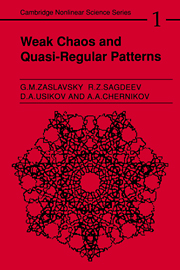Book contents
7 - Two-dimensional patterns with quasi-symmetry
Published online by Cambridge University Press: 29 October 2009
Summary
The physical phenomena taking place in condensed matter are far more diverse than phenomena produced by the motion of discrete particles. As the number of degrees of freedom increases, the need arises for a qualitatively new analysis of the dynamics of matter. One of the important manifestations of the difference between these two cases is the formation of regular patterns in matter. Their examples are many and varied: crystals and vortex streets, convective cells and high clouds, fracture patterns and soap foam, the arrangement of seeds in a sunflower head and Jupiter's Great Red Spot, snowflake patterns and the ‘packing’ of live cells. The list could be continued indefinitely. It is only natural that we should yearn for universality in understanding all these phenomena. Following the recent discovery of quasi-crystals, we understand much more about the possible types of patterns and symmetries. Speaking of the symmetry of some particular object, we imply that it possesses a certain invariant property. Although in the analysis of spatial patterns and their symmetries, the use of geometrical methods is quite natural, dynamic methods might come in useful as well.
As demonstrated above, the dynamics of particles and fields can also exhibit certain symmetries. In this chapter we shall learn in which way symmetry in dynamic problems can help achieve and analyse symmetry in spatial patterns. For various reasons, the existence of this relation proves very fruitful and enables deeper penetration into the nature of things. Recall what efforts and ingenuity it took Kepler to convince his readers of the existence of certain formative forces and factors. Spatial patterns and laws of their growth are determined by interaction (Note 7.1).
Information
- Type
- Chapter
- Information
- Weak Chaos and Quasi-Regular Patterns , pp. 143 - 169Publisher: Cambridge University PressPrint publication year: 1991
